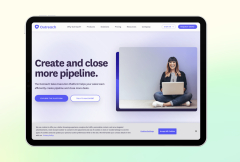3 Lessons Learned For B2B Sales Enablement In The Customer Era
- Written by Brian Faussette
- Published in Blog
In 2019, the sales enablement platform market tallied $1.1 billion, and that number is projected to climb up to $2.6 billion by 2024. Also, 76% of organizations increased their enablement budget. This trend in sales enablement is indicative of “the customer era,” a time where customers feel more in control and have higher expectations of the customer experience during the buying process.
As more customers step up to the plate, businesses must evolve to meet increasing demands through implementing or refining their own selling or marketing practices. The foundation of sales enablement is to provide sales teams with what they need to successfully engage the buyer throughout the buying process, but what role can AI intelligence and a conversational framework have?
While sitting in on a few sessions during the Strategy & Planning Series, I learned about the vitality of the sales industry as a whole and how businesses can better adapt to remove friction and improve sales enablement.
Lesson 1: Prioritize the removal of friction from the buying process
B2B customers want to rely on sales representatives as a trusted advisor, and the foundation of any relationship is conversation. Conversations spark relationships, and relationships can spark sales. Mark Kilens, Vice President of Content and Community at Drift, and Sara Pion, a Growth Marketer at Drift, discuss how abiding to a conversational framework can improve sales and make for a more frictionless buying process. Removing friction helps sales team connect with the right people faster and enhance brand reputation, but there are still too many cases of customers finding a site hard to navigate or having trouble finding answers to simple questions. Having AI-intelligence, such as bots, run in the backend of a site can lend a company the ability to provide more personalized or guided instructions and a specific course of action.
Lesson 2: Recognize sales enablement as more than just enabling sales
Bryan Ehrenfreund, a Sales and Marketing Leader at Ossia, further discusses how AI algorithms can help predict a lead’s next move and give the seller a better idea of the customer’s spending habits. With consensus and committee buying scenarios becoming more relevant and organizations beginning to enable additional roles outside of traditional sales, it is clear that sales itself as an industry is growing. Sales enablement involves training, metrics, strategies and more tools to ensure frictionless processes for both the seller and the buyer. Sales enablement is not all about enabling sales, but it is about enabling growth throughout an entire organization to drive revenue, serving as an umbrella over various teams and silos such as customer support and channel partners. With the average adult attention span for digital tasks sitting around 40 seconds, Ehrenfreund also suggests more “snackable content” as a way to better target certain demographics.
Lesson 3: Integrate sales enablement with sales readiness & training tools
Chris Bogosh, a Customer Success Manager at Seismic, shares that companies are increasingly engaging with their sales enablement platform to integrate with sales readiness and training tools. Seismic’s four-pronged approach to sales enablement involves personalization, analytics, automation and education. Illumina, a company that markets integrated systems for the analysis of genetic variation, saw a 5-6X increase in content usage and 3X increase in platform usage after taking the measures to properly evaluate their adoption of sales enablement technology.









